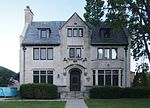St. Paul Curling Club
1885 establishments in MinnesotaCurling clubs established in 1885Curling clubs in the United StatesCurling in MinnesotaSports in Saint Paul, Minnesota
The St. Paul Curling Club (SPCC) is an historic curling club located in Saint Paul, Minnesota, United States, on Selby Avenue. It is the curling club with the largest active membership in the United States at over 1200 members. It was first established in 1885, and the present St. Paul CC was established when the Capitol City Curling Club and Nushka Curling Club merged in 1912. It is the oldest curling club in Minnesota. The club hosted the 2011 World Mixed Doubles Curling Championship and the 2011 World Senior Curling Championships in April 2011.
Excerpt from the Wikipedia article St. Paul Curling Club (License: CC BY-SA 3.0, Authors).St. Paul Curling Club
Selby Avenue, Saint Paul Summit - University
Geographical coordinates (GPS) Address Phone number Website External links Nearby Places Show on map
Geographical coordinates (GPS)
| Latitude | Longitude |
|---|---|
| N 44.946111111111 ° | E -93.119722222222 ° |
Address
Saint Paul Curling Club
Selby Avenue 470
55102 Saint Paul, Summit - University
Minnesota, United States
Open on Google Maps







